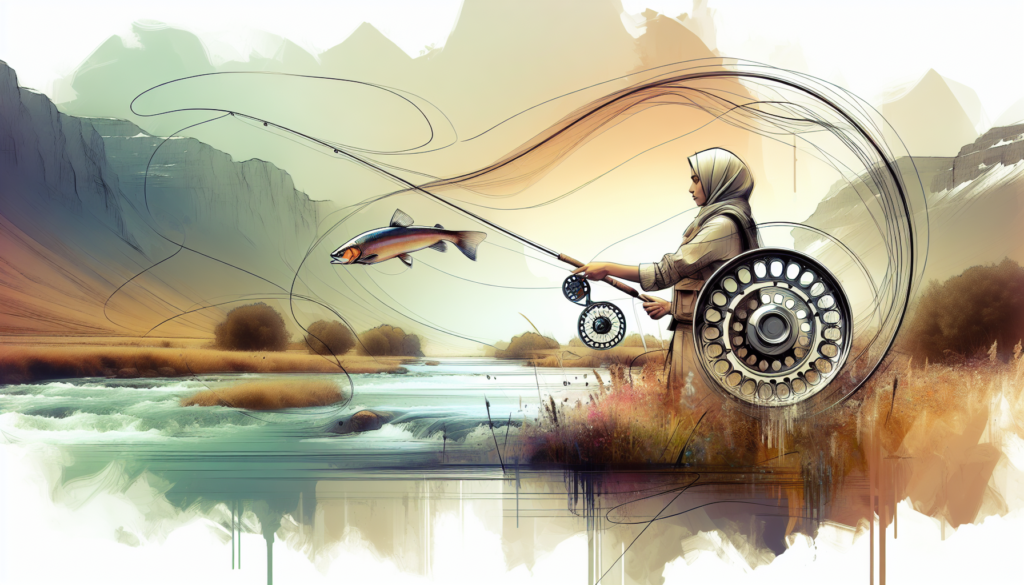Are you ready to take your fly fishing skills to the next level? Whether you’re a beginner or an experienced angler, mastering the art of fly fishing casting is essential for a successful day on the water. In this article, we will explore the fundamentals of fly fishing casting, from understanding the equipment and choosing the right fly line to executing the perfect cast. Get ready to improve your accuracy, distance, and overall technique as we guide you through the fly fishing casting basics.
The Basics of Fly Fishing Casting
What is Fly Fishing Casting?
Fly fishing casting is the technique of propelling a fly line, leader, and fly through the air in order to catch fish. Unlike traditional spin casting or baitcasting, fly fishing casting relies on the weight of the fly line to carry the fly to the desired location. This method requires skill and precision, as the angler must use the fly rod to create the necessary momentum to cast the line.
Why is Casting Important in Fly Fishing?
Casting is a fundamental aspect of fly fishing and is crucial for a successful fishing experience. A well-executed cast allows the angler to present the fly in a natural and appealing manner to the fish. It is the initial point of contact between the angler and the target species. By mastering the art of casting, you increase your chances of attracting fish, getting the fly exactly where it needs to be, and ultimately hooking and landing your desired catch.
Understanding the Fly Fishing Cast
The fly fishing cast consists of several components, including the grip and stance, loading the rod, the backcast, and the forward cast. These elements come together to create a smooth and efficient casting motion. It is important to understand each step of the cast in order to achieve accuracy and distance.
Equipment Needed for Fly Fishing Casting
To engage in fly fishing casting, you will need several pieces of equipment. The most essential items include a fly rod, fly reel, fly line, leader, and flies. Each component plays a crucial role in the casting process. Fly rods come in different weights and lengths, and the choice will depend on the type of fishing you plan to do. The fly reel holds the fly line and provides drag when fighting fish. Fly lines come in various types, weights, and tapers, each designed for specific fishing conditions. Leaders are tapered nylon or fluorocarbon lines that connect the fly line to the fly. Finally, the fly is the imitation insect, baitfish, or other food source that attracts fish.
Types of Fly Fishing Casts
Overhead Cast
The overhead cast is the most common and basic cast used in fly fishing. It involves making a backcast behind you and then bringing the rod forward to propel the line towards the target. This cast is effective for casting at greater distances and in open areas.
Roll Cast
The roll cast is ideal for fishing in tight quarters or when obstacles are present behind the angler. It requires less room for backcasting and involves rolling the fly line on the water’s surface to generate the forward energy needed to cast the line.
Reach Cast
The reach cast is a casting technique used to present the fly in a different direction than the current. By extending the fly line with a reach cast, you can mend the line and achieve a drag-free drift, increasing your chances of enticing a fish to strike.
Mending
Mending is a technique used during the drift of the fly to control the drag and presentation. By manipulating the fly line on the water’s surface, you can adjust the speed and direction of the fly, making it appear more natural to the fish.
Hauling
Hauling is a casting technique that adds additional line speed and power to the cast. By using your non-casting hand to pull in excess line during the casting stroke, you can generate more line speed and lengthen the cast. This technique is especially useful in windy conditions or when casting heavy flies or sinking lines.

Casting Techniques
Grip and Stance
The grip and stance in fly fishing casting are crucial for controlling the rod’s movement and achieving an accurate cast. Hold the rod with a relaxed grip, allowing for easy movement and flexibility. Your stance should be balanced, with your feet shoulder-width apart and your body aligned with the target area.
Loading the Rod
Loading the rod is the process of storing energy in the rod for an efficient cast. By flexing the rod on the backcast and then releasing the energy on the forward cast, you can achieve a powerful and accurate cast. Proper timing and technique are essential to effectively load the rod.
Backcast
The backcast is the movement of the rod towards the rear to propel the line and fly line behind you. It is important to pause and allow the line to straighten in the air before initiating the forward cast. This ensures that the line has enough momentum to carry the fly to the target.
Forward Cast
The forward cast is the final movement of the rod towards the target, propelling the line and fly forward. It is important to maintain a smooth and fluid motion, accelerating the rod through the casting stroke. The forward cast should end with a firm stop to transfer the stored energy into the line and achieve distance and accuracy.
Timing and Rhythm
Timing and rhythm are crucial for a successful fly fishing cast. The casting stroke should be smooth and continuous, with a pause between the backcast and forward cast to allow the line to fully extend. Developing a consistent and rhythmic casting motion will improve your accuracy and distance.
Excessive False Casting
False casting refers to the repeated back-and-forth motion of the fly line without actually presenting the fly to the fish. Excessive false casting can spook fish and waste energy. Minimize false casting by utilizing proper line management and learning to control the length and speed of the cast.
Common Casting Mistakes
Casting Too Hard
One of the most common mistakes in fly fishing casting is casting too hard. Casting with excessive force can result in line tangles, poor accuracy, and a lack of distance. It is important to focus on smooth and controlled casting motions to achieve optimal results.
Casting with a Closed Loop
Another common mistake is casting with a closed loop. A closed loop refers to a circular or oval shape formed by the fly line during the casting motion. This occurs when the line is not fully extended or when the rod tip is not properly aligned. A closed loop can lead to decreased casting efficiency and accuracy.
Poor Timing
Poor timing is a common casting mistake, especially for beginners. It refers to the improper synchronization of the backcast and forward cast. Casting too soon or too late can result in a loss of rod loading, decreased casting distance, and accuracy. Practice timing and rhythm to improve your casting technique.
Improper Rod Positioning
Improper rod positioning can negatively impact casting accuracy and distance. The rod should be positioned in a straight line throughout the casting stroke, with the tip following a straight path. Avoid excessive wrist movement and focus on keeping the rod in the correct position to maximize casting efficiency.
Not Keeping the Line Straight
Failure to keep the line straight during the casting motion can lead to problems such as line tangles, decreased distance, and accuracy. Focus on maintaining a straight line path and minimize unnecessary movements to ensure a smooth and efficient cast.

Tips for Improving Your Fly Fishing Casting
Understanding the Rod Action
Understanding the action of your fly rod is crucial for effective casting. Rod action refers to the flexibility and responsiveness of the rod. Fast-action rods are stiffer and require more force to load, while slow-action rods are more forgiving and easier to cast. Choose a rod that suits your casting style and skill level.
Practicing Your Cast
Practice is key to improving your fly fishing casting technique. Set aside time to practice your cast in different conditions and environments. Experiment with different casting strokes, distances, and targets. By dedicating regular practice sessions, you will develop muscle memory and improve your casting accuracy and distance.
Consistency in Execution
Consistency in execution is important for mastering fly fishing casting. Focus on maintaining the same grip, stance, and casting motion with each cast. Consistency allows you to become more familiar with your equipment and develop a predictable and effective casting technique.
Adjusting for Wind
Wind can greatly affect your casting accuracy and distance. Learning to adjust for wind conditions is crucial for successful fly fishing. Modify your casting stroke by decreasing the height of the cast, increasing line speed, and utilizing techniques such as hauling to combat the effects of wind.
Keeping an Eye on the Line
Keeping an eye on the line throughout the casting motion is essential for detecting any tangles, knots, or potential issues. By observing the line, you can make corrections in real-time, optimize your casting technique, and prevent problems before they occur.
Choosing the Right Fly Fishing Line
Weight Forward (WF) Line
Weight forward (WF) line is the most popular and versatile type of fly line. It features a tapered design with the majority of the weight concentrated in the first 30 feet of the line. WF line helps load the rod efficiently, allowing for greater casting distance and accuracy.
Double Taper (DT) Line
Double taper (DT) line is an alternative to weight forward line. It features an even taper from one end to the other, allowing for more delicate presentations and better control. DT line is effective for casting at shorter distances and in situations that require precise casting.
Shooting Taper (ST) Line
Shooting taper (ST) line is specifically designed for long-distance casting. It features a thin running line section that allows for minimal friction and increased line speed. ST line is ideal for anglers who need to cast over long distances, such as saltwater or surf fishing.
Sinking Line
Sinking line is designed to sink below the water’s surface. It is useful for fishing in deep water or targeting fish that inhabit the lower depths. Sinking lines come in different sink rates, allowing you to choose the appropriate line for the fishing conditions you encounter.
Floating Line
Floating line is designed to stay on the water’s surface. It is the most commonly used line type and is versatile for a variety of fishing situations. Floating lines are optimal for dry fly fishing, where the fly stays on the surface of the water.
Fly Fishing Casting Techniques for Different Situations
Casting in Still Water
Casting in still water requires a delicate touch and precise presentation. Avoid creating excessive disturbances on the water’s surface and focus on presenting the fly in a natural manner. Longer casts may be necessary to reach fish in deeper water.
Casting in Moving Water
When casting in moving water, it is important to consider the current’s speed and direction. Adjust your casting angle and mending techniques to ensure a natural drift of the fly. You may need to cast slightly upstream and mend the line to achieve the desired presentation.
Casting in Tight Spaces
Casting in tight spaces, such as areas with trees or bushes, requires accuracy and control. Utilize roll casts and sidearm casts to navigate through obstacles without getting tangled. Shorter casts with minimal false casting may be necessary in tight spaces.
Casting in Windy Conditions
Windy conditions can make casting challenging, but there are techniques to overcome this obstacle. Adjust your casting stroke to decrease the height of the cast and increase line speed. Utilize hauling to generate more power and minimize the effects of wind.
Casting with Weighted Flies
Weighted flies require adjustments to your casting technique. Utilize a more powerful casting stroke to propel the heavier fly through the air. Be mindful of the added weight, as it can affect your timing and coordination.
How to Mend Your Fly Line
What is Line Mending?
Line mending refers to the act of repositioning the fly line on the water’s surface after the cast to achieve a desired drift or presentation. Mending allows you to adjust the speed, direction, and depth of the fly, increasing your chances of enticing a fish to strike.
Upstream Mend
An upstream mend involves repositioning the fly line upstream of the fly after the cast. This technique creates a drag-free drift and allows the fly to naturally present itself to the fish. Upstream mends are useful when fishing in faster currents.
Downstream Mend
A downstream mend involves repositioning the fly line downstream of the fly after the cast. This technique slows down the speed of the fly and can be used to achieve a natural drift in slower currents. Downstream mends are effective for fishing in slower-moving water.
Mending for Drift
Mending for drift involves using a combination of upstream and downstream mends to control the speed and direction of the fly during the drift. By strategically mending the line, you can maintain a natural presentation and increase your chances of success.
Mending for Presentation
Mending for presentation refers to adjusting the line to achieve a desired fly presentation. This may involve mending to avoid drag, imitate natural movement, or target specific areas of the water. Proper line control and mending technique are essential for presenting the fly effectively.
Advanced Casting Techniques
Double Haul
The double haul is an advanced casting technique that involves utilizing both the rod hand and the line hand to generate additional line speed and power. By pulling on the line during the casting stroke, you can load the rod more efficiently and achieve longer casts. The double haul is particularly useful in windy conditions or when casting heavy flies or sinking lines.
Curve Cast
The curve cast is a casting technique used to deliver the fly in a curved path. This can be useful when there are obstacles in the water, or when trying to imitate the movement of a natural insect. By utilizing a sidearm casting stroke and altering the angle of the cast, you can curve the line and achieve precise presentations.
Roll Cast Pickup
The roll cast pickup is a technique used to bring the line and fly back to the angler without executing a backcast. It is useful when fishing in situations where backcasting is difficult or not possible, such as when there are obstacles behind you. By rolling the line on the water’s surface and smoothly lifting the rod, you can retrieve the line and prepare for the next cast.
Snake Roll Cast
The snake roll cast is a casting technique that allows for quick changes in the direction of the cast. It involves a series of wide loops in the line that resemble a snake’s movement, hence the name. The snake roll cast is useful when fishing in circumstances that require sudden changes in the direction of the fly.
Reach Mend
The reach mend is a casting technique used to create a drag-free drift and control the presentation of the fly. By extending the line with a reach cast and then mending downstream, you can achieve an extended drag-free drift and present the fly in a natural manner. The reach mend is particularly effective when fishing in currents that require precise control of the fly.
Troubleshooting Common Casting Problems
Leader and Tippet knots
Leader and tippet knots can cause casting problems if not properly tied or if they become damaged or tangled. Check your knots regularly and ensure they are secure. Replace any damaged or tangled sections to prevent line failure and casting issues.
Tangles and Knots in the Line
Tangles and knots in the line can disrupt the casting motion and decrease casting efficiency. Take the time to untangle any knots or tangles before continuing to cast. Proper line management and awareness can help prevent these issues from occurring.
Line Slap and Splashdown
Line slap and splashdown occur when the line hits the water’s surface with force, creating excessive noise and disturbance. This can spook fish and reduce your chances of success. Focus on casting with finesse, controlling the line’s descent, and minimizing the impact on the water.
Fly Dropping Like a Rock
If your fly drops like a rock and fails to present itself naturally, it could be due to an improper casting technique or a fly that is too heavy for your current tackle. Adjust your casting stroke and consider using a lighter fly to achieve a more delicate presentation.
Line Not Shooting
If your line fails to shoot or extend fully during the cast, it could be due to various factors such as improper timing, a lack of power, or excessive friction caused by a dirty or damaged line. Focus on your casting technique, ensure sufficient power, and regularly clean and maintain your fly line for optimal performance.
With an understanding of the basics of fly fishing casting, the different types of casts, casting techniques, and common casting mistakes, you are well on your way to enhancing your fly fishing skills. By practicing, refining your technique, and continuously learning, you will become a confident and proficient fly caster. So grab your gear, head out to the water, and enjoy the art of fly fishing casting!
